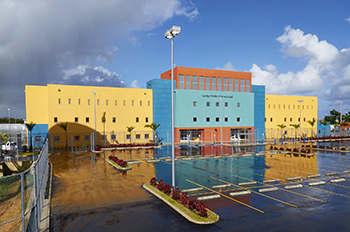Bayamon Regional Prison Opens Medical Center
 BAYAMON, Puerto Rico — The recently completed Centro Medico Correctional (CMC) facility in Bayamon received the Distinction Team Award at the 2015 Healthcare Facilities Symposium & Expo for its design and the contribution project architects made to the correctional health care design industry. New York-based Urbahn Architects worked as the lead design architect with Puerto Rico’s DS+C Architects + Engineers to complete the project.
BAYAMON, Puerto Rico — The recently completed Centro Medico Correctional (CMC) facility in Bayamon received the Distinction Team Award at the 2015 Healthcare Facilities Symposium & Expo for its design and the contribution project architects made to the correctional health care design industry. New York-based Urbahn Architects worked as the lead design architect with Puerto Rico’s DS+C Architects + Engineers to complete the project.
The 200-bed facility will serve not only the Bayamon Regional Prison, but will also provide services to the island’s 44 correctional facilities, said Donald E. Henry Jr. AIA, LEEP AP, principal at Urbahn, in a statement. While planning the three-story facility, the team created a design that fit within the island’s aesthetic — including a stucco exterior, for instance — to make it a more approachable correctional facility. “It is a bright and colorful structure that evokes an aura of wellness rather than a forbidding hallmark of incarceration,” Henry Jr. said in a statement.
Security was a main concern during the design and construction of the medical center. The design established separate paths for circulation for staff and visitors and the inmates to ensure security. All of the windows are secured using steel security bars. The team used stucco on the outside and placed vertical reinforcing bars through cores of masonry block in the ceilings and floors.
Additionally, the site is equipped with a security perimeter, an extensive electronic monitoring and locking system, and sallyports for vehicles as well as staff placed at building entrances and unit entries on the interior. The sallyports were necessary for the medical center to provide service to inmates throughout Puerto Rico.
“We had to coordinate all of the systems — security, mechanical, electrical, fire protection, everything — to integrate it all properly. It required a great deal of synchronization among the team members,” said Martin Davila, AIA, DS+C principal at Urbahn, in a statement.
Honeywell custom-designed a state-of-the-art central security system with touch-screen technology. Surface parking, roadways, a perimeter fence for security and a Cultec Recharger 330XLHD storm water detention system, which provided 25,507 cubic feet of storage capacity, were also added to the site.
The project team also created a reinforced-concrete structure using local construction methods without using structural steel frame components, according to a statement.
Although the medical center required extra security and additional spaces such as the sallyports and separate areas for inmates and staff, the 139,000-square-foot medical center came in 15 percent under budget with a price tag of $68 million, according to Henry Jr.
The design team had to perform careful programming, master planning, and space planning and design analysis to reach the perfect balance in designing for both corrections and health care. “We had to abide by federal mandates regarding outdoor views and recreational space, all without compromising security,” Henry Jr. said in a statement. “We also strived to provide a humane environment and appropriate medical care to a chronically underserved population, while creating strong and uplifting architecture.”
Prison health care facilities have very different privacy considerations than a typical health care center, which can make it difficult to design. In a health care center, HIPAA rules that privacy is very important to the patient, but security concerns at a correctional facility are more important than the privacy of an inmate. As such, Urbahn designers drew on their own knowledge of health care and correctional construction, and worked closely with consultants to ensure that all requirements were met, according to a statement. The layout planning, equipment and engineering methods used during construction were chosen to create an environment that met all requirements.
Officer stations and nurse’s stations were designed similarly, but in separate locations to ensure that medical records were kept safe. This allows the correctional officers to be able to watch inmate at all times in a secure environment, while also giving individual inmates privacy, as the officers are not permitted to see their medical health records.
“The Bayamon CMC had to address varying populations with disparate physical, health and security needs. By working closely with the client, Urbahn, the program manager and the consultants, we created a facility that is essential to the health and well-being of both pretrial detainees and sentenced inmates,” said Davila in a statement.
This article was originally published on Correctional News.
